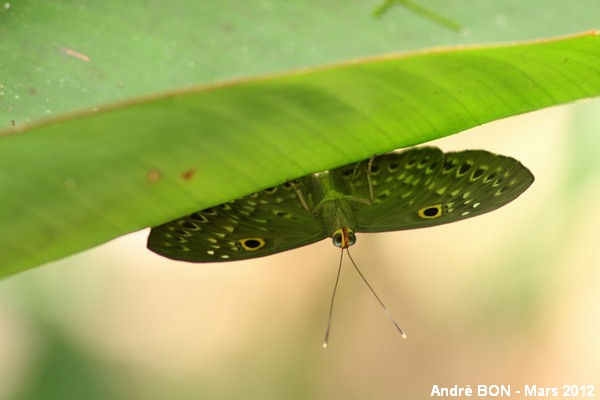
| Eurybia sp. (Illiger, 1807) |

|
|
Scientific name: Eurybia sp. (Illiger, 1807) Common name: French name: Order: Lepidoptera Suborder: Rhopalocera Family: Riodinidae Subfamily: Riodininae Wingspan: 38 to 54 mm. Biotope: Tropical rain forest, always in dark places. They are often observed landed upside down, their wings wide open, on the underside of the leaves of low growing vegetation. The head is just positioned near the edge of the leaf to be able to see any eventual predator. Geographic area: Central America and South America, from Mexico to Bolivia. Flight time: All year round. Number of generations : Caterpillar: At their first development stages, the caterpillars look like maggots and feed on flowers. Then ants are taking care of them. Host plant: Marantaceae of the Calathea, Ischnosiphon and Maranta genera with Zingiberaceae of the Renealmia genus and Costaceae of the Costus genus. |
The Eurybia genus includes species which show a rounded marginal edge on their hind wings and a straighter marginal edge on their fore wings with a slightly curved costal edge. The upper side of the wings is generally greyish or brownish, with, depending on species, blue or orange marks or eyespots on the hind wings. Almost all species show an eyespot, circled with orange, clearly visible in the discal cell of the fore wings. Some species, like Eurybia halimede as an example, miss this eyespot. The antennae are rather long, about two third of the length of the costal edge. They are slightly swollen at the tip. They are blackish with a grey ring and a yellowish tip. The butterflies of the Eurybia genus have a very long proboscis so that they can get nectar deep inside the flowers of the Heliconia genus. I have found the following subspecies listed in French Guiana , Eurybia nicaeus nicaeus, Eurybia dardus dardus, Eurybia caerulescens palikourea, Eurybia halimede halimede. |
| [To know more about the Eurybia sp.] [Top] |

|
I have shot this picture at Saül, while walking along the Gros arbres footpath. I have been able to rule out the Eurybia halimede species because of the presence of eyespots in the fore wings' cell. My knowledge is too limited, and the picture is maybe not enough, to be able to choose between the other possible species. |